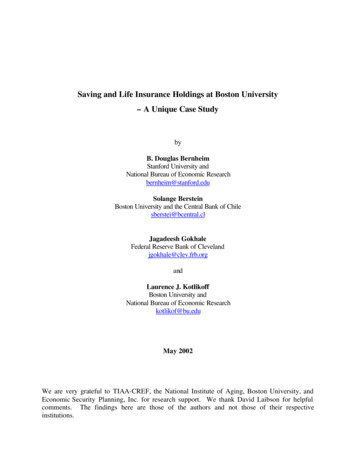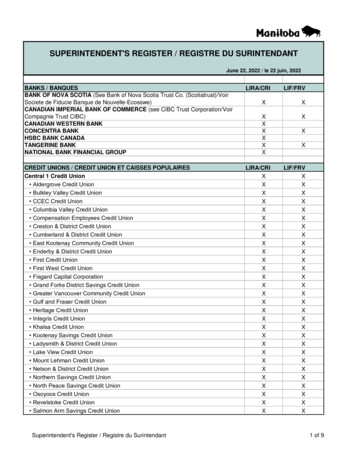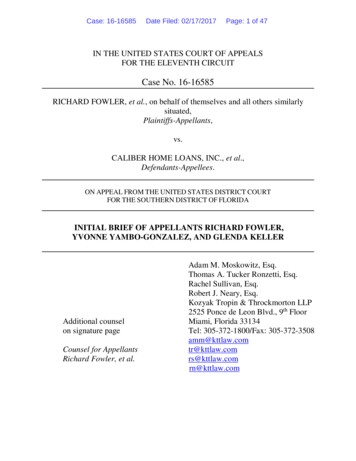
Transcription
Saving and Life Insurance Holdings at Boston University– A Unique Case StudybyB. Douglas BernheimStanford University andNational Bureau of Economic Researchbernheim@stanford.eduSolange BersteinBoston University and the Central Bank of Chilesberstei@bcentral.clJagadeesh GokhaleFederal Reserve Bank of Clevelandjgokhale@clev.frb.organdLaurence J. KotlikoffBoston University andNational Bureau of Economic Researchkotlikof@bu.eduMay 2002We are very grateful to TIAA-CREF, the National Institute of Aging, Boston University, andEconomic Security Planning, Inc. for research support. We thank David Laibson for helpfulcomments. The findings here are those of the authors and not those of their respectiveinstitutions.
AbstractThis study examines the saving and insurance behavior of 386 Boston University employees whovolunteered to receive financial planning based on ESPlanner (Economic Security Planner) – adetailed life-cycle financial planning model developed by Economic Security Planning, Inc.Because the employees received their own financ ial plan, they had a strong incentive to providefull and accurate financial information. Hence, the data appear to be of particularly high qualityfor studying saving and life insurance decisions.ESPlanner recommends annual levels of consumption, saving, and life insurance holdings thatsmooth a household’s living standard through time subject to the household not exceeding itsself-ascribed borrowing limit. The program treats housing and special expenditures as “off- thetop,” adjusts for economies in shared living and the relative costs of raising children, makeshighly detailed tax and Social Security benefit calculations, and permits users who don’t want astable living standard to specify how they’d like their living standard to change through time.Our findings are striking. First, the correlation between ESPlanner’s saving and insuranceprescriptions and the actual decisions being made by BU employees is very weak in the case ofsaving and essentially zero in the case of life insurance. Many employees are spending far moreand saving far less than they should, while others are under-spending and over-saving. The sameholds for life insurance. The degree of under- insurance seems particularly acute. Almost 13percent of those BU spouses who are secondary earners would experience a 40 percent or greaterdrop in their living standards were their spouses to pass away in the near future. Another 13percent would experience a 20 to 40 percent drop. Second, planning shortcomings are ascommon among high- income professors with significant financial knowledge as they are amonglow-income staff with limited financial knowledge.Third, two thirds of BU employees are not in a position to smooth their living standards withoutexceeding their debt limits. Borrowing constraints are not only ubiquitous; they are alsosignificant. Consider, for example, the University’s 403(b) plan, participation in which imposesborrowing constraints on almost two thirds of sample households. Were this plan eliminated andworkers directly paid what the University would otherwise be contributing to their 403(b)accounts, current consumption of married and single households would, on average, rise by 9.0and 20.4 percent, respectively. And consumption at retirement would fall, on average, by 8.0percent and 10.4 percent, respectively.Fourth, although it limits the current spending of sample households, participation in definedcontribution plans significantly lowers their lifetime taxes and raises their lifetime spending.Among married households, eliminating, on a compensated basis, all defined contribution planswould, on average, raise our sample’s married couples’ lifetime taxes by 4.5 percent and theirlower lifetime spending by 1.7 percent. For singles, the comparable figures are 6.1 percent and2.2 percent.I. Introduction
This study examines the saving and insurance behavior of 268 married and 118 singleBoston University employees who volunteered to receive financial planning based onESPlannerTM (Economic Security Planner) – an elaborate life-cycle financial planning programdeveloped by Economic Security Planning, Inc. Study participants received their financial planfor free. They also were given the choice of receiving either a free copy of ESPlanner, togetherwith their input file, or a cash payment that ranged from 25 to 100. Because the employeesknew they were helping to generate their own financial plan, they had a strong incentive toprovide full and accurate financial information. Hence, the data collected from the planningsessions appear to be of particularly high quality for studying saving and life insurance decisions.ESPlanner determines annual levels of consumption, saving, and life insurance holdingsthat smooth a household’s living standard through time subject to the household not exceedingits self-declared borrowing limit. The program treats housing and special expenditures as “offthe-top,” adjusts for economies in shared living and the relative costs of raising children, makeshighly detailed tax and Social Security benefit calculations, and permits users who don’t want astable living standard to specify how they’d like their living standard to change through time.The demographic and financial data solicited by ESPlanner are extensive and detailed. Inthe case of married couples, they include ages of the household head and spouse, maximum agesof life of the household head and spouse, the ages of children under 19, current market values ofregular and retirement account assets, current and future levels of wage and self-employmentearnings, current and future special expenditures, current and future special receipts, currenthousing and future housing plans, current and future receipt of pension benefits, desiredbequests, expected funeral costs, borrowing limits, desired future living standard changes,desired changes in survivors’ living standards, actual current saving, actual current life insurance1
holdings, intended dates of withdrawal from retirement accounts, current and projectedcontributions to retirement accounts, expected nominal rates of return on regular and retirementaccount assets, the expected rate of inflation, current Social Security benefits, past and futureSocial Security-covered earnings, the degree of economies in shared living, projected future cutsin Social Security benefits, and the costs of supporting children relative to adults.We take ESPlanner’s consumption, saving, and life insurance recommendations as areference point from which to consider actual choices of these variables. Large and widespreaddeviations of ESPlanner’s recommended levels of consumption, saving, and life insurance fromactual levels would suggest that BU employees are making significant financial planningmistakes.This, unfortunately, is exactly what we find.Indeed, the correlation betweenESPlanner’s saving and insurance prescriptions and the actual decisions being made by BUemployees is very low in the case of consumption and saving and essentially zero in the case oflife insurance.Many employees are spending much more and saving much less than theyshould, while others are under-spending and over-saving.The same holds for life insurance.worrisome.The degree of under- insurance is particularlyAlmost 13 percent of those BU spouses who are secondary earners wouldexperience a 40 percent or greater drop in their living standards were their partners to pass awayin the near future. Another 13 percent would experience a 20 to 40 percent drop.While one might expect that those BU employees who appear to be making financialmistakes would be less well educated or have less financial knowledge, this is not the case.Highly compensated professors with substantial knowledge of financial matters are just as likelyas staff members with little financial acumen to make what appear to be inappropriate saving andinsurance decisions.2
In addition to studying saving and insurance behavior, our study addresses a range ofquestions about household financial behavior that have previously been hard to investigate. Oneexample is the degree to which households face liquidity constraints. In our sample, 66.4 percentof married couples and 67.8 percent of singles are unable to perfectly smooth their livingstandards. Younger households with lower incomes and levels of regular assets are much morelikely to be borrowing constrained.But borrowing constraints also limit the consumptionsmoothing of one third of older households with high incomes and large amounts of assets.A second example is the degree to which BU’s generous 403(b) retirement saving planlimits consumption smoothing. We considered a) eliminating the plan, but b) having theUniversity increase each employee’s direct pay by the amount it would otherwise havecontributed to their 403(b) account. According to ESPlanner, this policy would increase thecurrent consumption of married employees by 9.0 percent and that of single employees by 20.4percent. Retirement consumption of married employees would decline by 8.0 percent and that ofsingle employees by 10.4 percent.A third example is the degree to which households differ with respect to the rates ofreturn they expect to earn on their investments. Just over 80 percent of BU employees used theprogram’s 3 percent real return default assumption. Another 8 percent set their real returnsbelow 3 percent, and the remainder set their real returns above 3 percent, with only 1 percentsetting their real returns at 8 percent or higher.The paper proceeds with a review of the literature, an overview of ESPlanner, adescription of the survey protocol and data collection, and a presentation of findings. The finalsection concludes with suggestions for future research.3
II. Literature ReviewThis is the third in a series of studies that use ESPlanner to examine household financialdecisions. Bernheim, Carman, Gokhale, and Kotlikoff (2001) and Bernheim, Forni, Gokhale,and Kotlikoff (2001) examined life insurance holdings of respondents in the Survey of ConsumerFinances (SCF) and the Health and Retirement Study (HRS), respectively.Both studiesdocument a startling mismatch between the amounts of life insurance that individuals hold andthe underlying insurance needs of their potential survivors. In particular, they find virtually nocorrelation between these two variables regardless of age, income, or other demographic orfinancial characteristics.For those in need of insurance, these findings are troubling. Consider secondary earnersin the SCF, which is a nation-wide survey. In the absence of life insurance, 56 percent ofsecondary earners would have experienced a 20 percent or greater decline in living standardupon the death of a spouse. Actual life insurance holdings reduced the fraction of secondaryearners exposed to such a severe decline in their living standard to 42 percent. Thus, the overallimpact of life insurance holdings on financial vulnerabilities among at-risk SCF households ismodest. Roughly two-thirds of poverty among widows women and more than one-third ofpoverty among widowers appears to reflect inadequate life insurance. While younger householdsare likely to have acquired/updated their life insurance holdings more recently than older ones,the evidence suggests that younger households are less adequately insured than older ones.The results based on the Health and Retirement Study, which covers Americansapproaching retirement, are much the same. Ignoring life insurance, 53 percent of secondaryearners would have experienced a 20 percent or greater decline in their living standards had their4
spouses died at the time of the survey. Actual life insurance holdings reduced this figure to 36percent.These findings resonate with those of Holden, Burkhauser, and Myers [1986] and Hurdand Wise [1989], who document sharp declines in living standards and increases in poverty rates(from 9 to 35 percent) among women whose husbands actually passed away. The findings alsoaccord with those of Auerbach and Kotlikoff [1987, 1991a, 1991b], who analyzed RetirementHistory Survey data gathered during the late 1960s. Auerbach and Kotlikoff report that roughlyone-third of wives and secondary earners would have seen their living standards decline by 25percent or more had their spouses died at the time of the survey.III. ESPlannerESPlanner uses dynamic programming to smooth a household’s living standard over itslife cycle to the extent possible without allowing the household to exceed its self-assessed debtlimit. Formally, the program’s algorithm is equivalent to maximizing the limit, as the coefficientof risk aversion goes to infinity, of a time-separable isoelastic utility function with periodspecific weights. This maximization is taken with respect to annual consumption levels andannual term life insurance holdings of the household head and, if married, his or her spouse.Non-negativity constraints on life insurance and debt limits constrain these decisions.The period-specific weights incorporate two elements.The first is the number ofequivalent adults projected to be living in the household in a given year adjusted for economiesin shared living.The second is the program’s Standard of Living Index. The number ofequivalent adults adjusted for economies in shared living is given by (N dK)σ, where N is 1 inthe case of singles and 2 in the case of married couples, σ determines the degree of economies in5
shared living, d is the child-adult equivalency factor, and K is the number of children. 1 A valueof σ equal to 1 implies no economies in shared living. A value of σ equal to 0 implies perfecteconomies in shared living. Our default value for σ of .678072 implies that raising the numberof equivalent adults from 1 to 2 raises the value of the formula from 1 to 1.6.The standard of living index can be specified at a different value for each future year.The index permits the household to tell the program whether it wants to have the same livingstandard in all future years, in which case the index is left at 100 for all future ye ars, or whetherit wants its living standard to vary through time, in which case the index values are set above orbelow 100. The index value for the current year is fixed at 100, so the user is actually specifyingthe desired living standard in a particular year relative to its living standard in the current year.In making its calculations, ESPlanner takes into account the non- fungible nature ofhousing, bequest plans, economies of shared living, the presence of children under age 19, andthe desire of households to make “off- the-top” expenditures on college tuition, weddings, andother special expenses. In addition, ESPlanner simultaneously calculates the amounts of lifeinsurance needed by each spouse to guarantee that potential survivors suffer no decline in theirliving standards compared with what would otherwise be the case.Life insurance amounts are calculated subject to non- negativity constraints. When theprogram recommends zero life insurance, survivors will have the same or higher living standardthan they enjoyed prior to the decedent’s death. Life insurance recommendations at each age arealso made for surviving spouses. 2 In this regard, the partner’s life insurance recommendation1This formula is a simplification of the one actually used in the program, which permits child-adult equivalencyfactors to vary with the age of the child.2The life insurance recommendations for survivors are determined separately depending on when the survivor firstbecomes widowed.6
takes into account the need for his (her) widow (widower) to pay insurance premium on her (his)own insurance policies.ESPlanner’s formulates its recommended time-paths of consumption expenditures,taxable saving, and term life insurance holdings in constant dollars of the current year.Consumption, in this context, is everything the household gets to spend after paying for its “offthe-top” expenditures – its housing expenses, special expenditures, life insurance premiums,special bequests, taxes, and contributions, net of withdrawals, to tax- favored accounts. Given thehousehold’s demographic information, preferences, and borrowing constraints, ESPlannercalculates the highest sustainable and smoothest possible living standard over time, leaving thehousehold with zero terminal assets apart from the equity in homes that the household choosesnot to sell.The amount of recommended consumption expenditures needed to achieve a given livingstandard varies from year to year in response to changes in the household’s composition. It alsorises when the household moves from a situation of being liquidity constrained to one of beingunconstrained. Finally, recommended household consumption will change over time if usersintentionally specify that they want their living standard to change, which, to repeat, they can dovia the standard of living index.ESPlanner’s algorithm is complicated. But users can check ESPlanner’s reports to seethat, given their data inputs, preferences, and borrowing constraints, the program recommendsthe highest and smoothest possible living standard over time. They can also readily verify thatthe recommended life insurance amounts will preserve the living standards of survivors and thatzero life insurance is recommended only if survivors will enjoy higher living standards if thepotential decedent in question passes away.7
Because taxes and Social Security benefits make a critical difference to how much ahousehold should consume, save, and insure, calculating these variables accurately is veryimportant. 3 ESPlanner has highly detailed federal income tax, state income tax, Social Security’spayroll tax, and Social Security benefit calculators. Its federal and state income-tax calculatorsdetermine whether the household should itemize its deductions, computes deductions andexemptions, deducts from taxable income contributions to tax-deferred retirement accounts,includes in taxable income withdrawals from such accounts as well as the taxable component ofSocial Security benefits, and calculates total tax liabilities after all applicable refundable and nonrefundable tax credits. These calculations are made separately for each year that the couple isalive as well as for each year a survivor may be alive. Moreover, tax and benefit calculations forsurviving wives (husbands) are made separately for each possible date of death of the husband(wife). I.e., ESPlanner considers each date the husband (wife) might die and calculates the taxesand benefits a surviving wife (husband) would pay and receive in each of her (his) remainingyears of life were she (he) to continue to survive. In calculating Social Security retirementbenefits, survivor benefits, mother and father benefits, children benefits, spousal benefits, anddivorcee benefits, ESPlanner takes into account the system’s eligibility requirements, wageindexation of earnings histories, inflation indexation of benefits, early retirement benefitreduction factors, recomputation of benefits, the delayed retirement credit, family benefitmaximums, and the recently modified earnings test.2. A Strategy for Measuring Financial VulnerabilitiesA. Concepts3See Gokhale, Kotlikoff, and Warshawsky (2001).8
We clarify our strategy for measuring financial vulnerabilities through an example.Imagine that a husband and wife each live for at most two years (equivalently, they are withintwo years of maximum lifespan). Both are alive initially, but either may die before the secondyear.The household’s well-being depends on consumption in the current year and in thefollowing year in each survival contingency. As discussed further below, we allow for thepossibility that certain expenditures (e.g., special expenditures and housing) are either exogenousor determined early in life by “sticky” choices.We refer to these expenditures as “fixedconsumption,” and to residual spending as “variable consumption.”Let y1 denote initial assets plus first period earnings net of fixed consumption, and let y2sdenote second period earnings net of fixed consumption in state s W, H, B, where the stateidentifies survivors (wife, W, husband, H, or both, B). The couple divides first period resourcesbetween variable consumption, c1 , saving, A, and insurance premiums, piLi, i H, W, where Lirepresents the second-period payment to i if his or her spouse dies, and pi denotes the associatedprice per dollar of coverage. Assets A earn the rate of return r.The couple faces the following constraints: c1 y1 - A - p WLW - pHLH, c2B y2B A(1 r),and c2i y2i A(1 r) Li for i W, H, where c2i denotes second period variable consumptionin state i (for the moment, we ignore non-negativity restrictions on life insurance and assets)Defining PB (1 r)-1 – PW - PH, these equations imply:(1)c1 p B c B pW cW pH c H y1 p B y B pW yW p H y H YWe equate living standard with per capita variable consumption adjusted for familycomposition. To determine each individual’s living standard when both are alive, we divide9
variable consumption by 2σ because there are no children in this example. To maintain a livingstandard c* for each person that is constant across time and states of nature (in this case,survivorship), the couple must spend 2σc* whenever both spouses are alive and c* when only onespouse is alive. From (1), we have(2)c* Y2 (1 p B ) ( pW p H )σThe couple can guarantee that spouse j’s death will not diminish i’s living standard bypurchasing a life insurance policy with a face value of Li (c* - y2i) (y2B - 2σc* ).4We measure underlying financial vulnerabilities by comparing an individual’s highestsustainable living standard, c* , with cin y2i A(1 r), which represents the living standard he orshe would enjoy if widowed, ignoring life insurance. We define the variable POTENTIALIMPACT as [( cin ci* ) 1] x 100, for i W, H. This is a measure of the percent by which thesurvivor’s living standard would fall short of or exceed the couple’s highest sustainable livingstandard absent any insurance protection.Similarly, we measure uninsured financial vulnerabilities by comparing c* with cia y2i A(1 r) Lia , which represents the living standard the widow(er) would actually enjoy givenactual life insurance coverage, Lia . We define the variable ACTUAL IMPACT as [( cia ci* ) 1] x100, for i W, H. This is a measure of the percent by which the survivor’s living standard4This is the utility-maximizing outcome in the case that the household has Loentief preferences defined over percapital expenditures adjusted for economies in shared living.10
would fall short of or exceed the couple’s highest sustainable living standard, given actual levelsof coverage .5For the preceding example, we implicitly assumed that individuals could borrow at therate r and issue survival contingent claims at the prices pH and p W. As a practical matter,households encounter liquidity constraints. They are also typically unable or at least veryreluctant to purchase negative quantities of life insurance (buy annuities). 6 In solving for eachhousehold’s highest sus tainable living standard, we take these restrictions into account,smoothing consumption to the greatest extent possible.7When the life insurance constraint binds, the recommended living standard for a survivor,ci* (where i H or W), may be greater than the recommended living standard for the couplewhile both spouses are still alive, cB* . This observation raises the following practical issue: whencalculating IMPACT, should we set c ci* or c cB* ? Were we to use cB* , ACTUAL IMPACTwould be positive no t only for households that depart from the recommendation by purchasingadditional insurance (Lia Li* ), but also for constrained households that conform to therecommendation by purchasing no insurance (Lia Li* 0). In contrast, the use of ci* implies thatACTUAL IMPACT is positive when Lia Li* and zero when 0 Lia Li* . Since we wish to useACTUAL IMPACT as a measure of the extent to which a household deviates from the5Note that when actual life insurance is below the benchmark, the intact couple saves on life insurance premiums,so the actual living standard per spouse exceeds c* . Hence the difference between the two impact variablesunderstates somewhat the change in living standard that an individual experiences upon a spouse’s death.6A non-negativity constraint for life insurance purchases is equivalent to the restriction that life annuities are notavailable for purchase at the margin. For further discussion, see Yaari (1965), Kotlikoff and Spivak (1981), andBernheim (1987).7Formally, one can think of the outcome that we identify as the limit of the solutions to a series of utilitymaximization problems in which the intertemporal elasticity of substitution approaches zero. In the limit (theLeontief case), the household is actually indifferent with respect to the distribution of consumption across any yearsin which its living standard exceeds the minimum level.11
consumption-smoothed (recommended) level, we select ci* rather than cB* . As a result, the valueof POTENTIAL IMPACT is always non-positive (even though, absent insurance, the survivor’smaterial living standard might actually increase upon his or her spouse’s death), and it equalszero whenever the corresponding recommended insurance level, Li* , is zero.One noteworthy difference between this and earlier studies of insurance adequacy is thatkey parameters such as maximum ages of life, planned retirement ages, future expected inflation,expected interest rates, the child-adult equivalency factors, planned future expenditures, funeralexpenses, bequests, and, in particular, desired living standards of survivors are provided by thesurvey participants rather than assumed by the researcher.Hence, ESPlanner’s calculatedsustainable living standards of joint and survivor households is based on a much larger set ofuser-defined parameters than is usually the case in similar studies. The same remark applies tothe program's recommended profiles of life insurance, consumption, and saving designed todeliver the maximum sustainable living standards for intact and surviving households.FindingsA. Characteristics of the BU Sample:Tables 1 and 2 report general characteristics of our sample for married and singlehouseholds, respectively. Consider first non- housing wealth. For married households the meanand median values of this variable equal 306,184 and 74,970, respectively. These figuresexceed the corresponding national values of 256,570 and 18,060 calculated from the 1998Survey of Consumer Finances. 8 For single households, mean non-housing wealth is 76,124,8All national statistics reported in this section are computed from the 1998 Survey of Consumer Finances. In ourcomputations, we define non-housing wealth as financial plus non- financial assets minus equity in residentialproperty.12
which is less than the national average of 94,101. However median non-housing wealth levelfor singles is 14,172 compared to a national median of 5,620.The smaller differencesbetween means and medians in the BU sample suggests that less dispersion in our sample than inthe overall population.The generally higher non- housing wealth levels in the BU sample is consistent with thefact that well over 80 percent of our sample respondents and their spouses hold college degreescompared to the national averages of 36 percent for married males, 29 percent for marriedfemales, and 33 percent for single household heads. As would be expected, married householdshave a much greater rate of ho me-ownership--83 percent--compared to that for singleindividuals--44 percent.The national rates of home-ownership for married and singlehouseholds are 79 percent and 49 percent, respectively.A small fraction of BU samplehouseholds are covered under defined benefit pensions (14 percent for married males and 9percent for single households). Finally, about 13 percent of married households and 26 percentof single households are non-white. The corresponding national percentages are 19 percent and27 percent.Panel 2 of Table 1 indicates that for married households, average actual insurance( 304,712) falls just short of the average recommended level ( 320,336) for husbands. BUautomatically provides its employees with a minimum of one-year’s salary in life insurancecoverage. This reduces the amount of insurance purchases required to achieve a given livingstandard for surviving household members.Purchased insurance averaged 249,226 forhusbands and 112,091 for wives. Husbands’ median total insurance is larger than medianrecommended insurance. For wives, both mean and median total insurance exceed the respectivemean and median recommended insurance levels. For singles, mean and median recommended13
insurance amounts are 32,654 and 0, while the mean and median of actual insurance are 109,317 and 52,000.On average, husbands would face an 8.78 percent living standard decline and wives a26.34 percent decline were their spouses to die completely uninsured. But, as indicated in thesecond from last row in Table 1, given actual life insurance holdings, the husbands would, onaverage, be better off to the tune of 2.32 percent, while the wives would, on average, be worseoff by only 4.94 percent. As a comparison of the husband and wife means in the last two rowsindicates, BU’s provision of life insurance appears to play a small role in reducing the financialrisk of widowhood among our sample. Note also that the mean percentage change in livingstandard results for primary and secondary earners are quite similar to those for husbands andwives since most husbands are primary earners.The median results on living standard changes indicate that, absent insurance, at least halfthe husbands would experience no drop on their living standar
detailed life-cycle financial planning model developed by Economic Security Planning, Inc. Because the employees received their own financial plan, they had a strong incentive to provide full and accurate financial information. Hence, the data appear to be of particularly high quality for studying saving and life insurance decisions.










